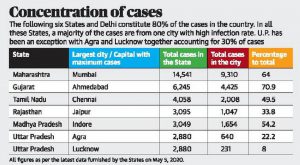MAY 6, 2020

Experts say failure to close Koyambedu market early led to explosion of cases
CHENNAI, INDIA – Months into the pandemic, pieces of the sub-cellular pathogenic puzzle seem to be falling into place. One thing amply clear now is that its spread is akin to a storm – dispersing from a focal point to a larger area.
This is exactly how Koyambedu market has come to infect large parts of Tamil Nadu.
An analysis of States that have had over 2,500 cases shows how it is often the biggest/busiest city that SARS-CoV-2 seems to strike in. The lesson that governments could take from this is to look for, in the initial stages, an epicentre and launch control measures.
In retrospect, perhaps the shutting down of the Koyambedu market comes at least a month late.
The signs were there for all to see. Chennai, which had the highest number of cases, also showed a high preponderance in its northern parts, which have a density of about 27,000 people per square km. The population density in Chennai, and Koyambedu market, are among the key reasons that make physical distancing difficult in the city.
Unlike in rural areas, where the landscape offers relief, cities such as Chennai do not have any such relief, says K. Kolandaisamy, former director of public health who led the COVID-19 control efforts until recently. “Physical distancing becomes an issue here. While it is the case that the public in the city show least conformity with stay-at-home rules, it is also because in several areas, especially in North Chennai, it is nearly impossible for people to maintain distance,” he explains.
“Cities are places where infection is magnified rapidly. In a village, or rural area, it will be much slower,” says T. Jacob John, eminent virologist. The driver of the epidemic will be cities, especially those with density, he adds.
The sprawl of Koyambedu and the sheer number of people working there and using it should have rung alarm bells for the powers that be.
A month late?
“It was not just the wholesalers, or retailers, but even residents who were going to Koyambedu for a mere kilo of tomatoes, and people who picked up flowers to sell in retail,” says a top official who calls the Koyambedu situation “extremely complicated”. Health experts point out that the market should have been closed at least a month ago, the explosion of cases may have been avoided. Also, the practice of stopping lorry drivers at the State border, testing them, and transferring the load onto lorries that would take the produce into Tamil Nadu, could have been adopted.
The jury is still out on how many cases and contacts actually caught their infection from Koyambedu. Cases in places as far as Kerala are being traced back to the market. “It may take us a few days to actually get down to the number of cases, or get down to all with the ‘Koyambedu strain’. More tests need to be done, clearly,” says J. Radhakrishnan, nodal officer, Greater Chennai Corporation, for COVID-19.
Courtesy/Source: The Hindu










































































































